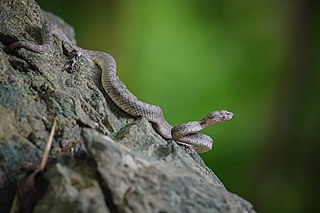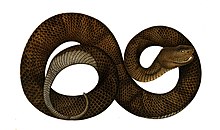
Craspedocephalus strigatus, commonly known as the horseshoe pit viper, is a venomous pitviper endemic to the Western Ghats. No subspecies are currently recognized.

Trimeresurus albolabris, the white-lipped pit viper, is a venomous pit viper species endemic to Southeast Asia.
Trimeresurus cantori, commonly known as the Cantor's pit viper, is a species of venomous snake, a pit viper in the family Viperidae. The species is endemic to the Nicobar Islands of India. It was named after Theodore Edward Cantor (1809-1860), a Danish naturalist serving as a surgeon with the East India Company in Calcutta. No subspecies are currently recognized.

Craspedocephalus gramineus, known as the bamboo pit viper, Indian green pit viper, or common green pit viper, is a venomous pit viper species found in the southern and north eastern parts of India.
Trimeresurus labialis, commonly called Nicobar bamboo pit viper, is a venomous pit viper species endemic to the Nicobar Islands of India. No subspecies are currently recognized.

Craspedocephalus macrolepis, commonly known as the large-scaled pit viper is a venomous pitviper species endemic to the Southern Western Ghats of South India. No subspecies are currently recognized.

Craspedocephalusmalabaricus, commonly known as Malabar pit viper, Malabar rock pit viper, or rock viper, is a venomous pit viper species endemic to the Western Ghats of southwestern India. No subspecies are currently recognised.

Trimeresurus popeiorum is a species of venomous pit viper in the family Viperidae. The species is native to northern and northeastern parts of India, Southeast Asia, and parts of Indonesia. Common names include: Pope's pit viper, Pope's tree viper, and Pope's bamboo pitviper. Two subspecies are currently recognized, including the nominate subspecies described here.

Trimeresurus purpureomaculatus is a venomous pit viper species native to India, Bangladesh and Southeast Asia. Common names include: mangrove pit viper, mangrove viper, and shore pit viper.

Trimeresurus stejnegeri is a species of venomous pit viper endemic to Asia. Two subspecies are currently recognized, including the nominate subspecies described here.

Trimeresurus flavomaculatus is a venomous pit viper species endemic to the Philippines. Two subspecies are currently recognized, including the nominate subspecies described here.

Craspedocephalus trigonocephalus, the Sri Lankan pit viper, Ceylon pit viper, Sri Lankan green pitviper or locally, pala polonga, is a venomous pit viper species endemic to Sri Lanka. No subspecies are currently recognized.

Trimeresurus kanburiensis is a species of pit viper found in only a few areas of Thailand. Common names include: Kanburi pitviper, Kanburian pit viper, and tiger pit viper. Highly venomous, it is an arboreal but heavily built species with a brown or tawny coloration. No subspecies are currently recognized.

Craspedocephalus puniceus is a venomous pitviper species endemic to Southeast Asia. Common names include: flat-nosed pitviper, flat-nosed pit viper, and ashy pit viper. No subspecies are currently recognized.

Trimeresurus sumatranus is a venomous pitviper species found in Thailand, Malaysia and Indonesia. Arboreal, its coloration is pale green with a red tail. Common names include Sumatran pitviper, Sumatran tree viper, and Sumatran pit viper.
Trimeresurus malcolmi is a venomous pitviper species found in East Malaysia. Common names include: Malcolm's pitviper, Malcolm's tree viper, and Mt. Kinabalu pit viper.

Craspedocephalus brongersmai, also known commonly as Brongersma's pit viper, is a species of venomous snake in the subfamily Crotalinae of the family Viperidae. The species is native to islands off the west coast of Sumatra, Indonesia. There are no subspecies that are recognized as being valid.

Trimeresurus hageni, commonly known as the Hagen's pit viper, is a species of pit viper, a venomous snake in the subfamily Crotalinae of the family Viperidae. The species is endemic to Southeast Asia. There are no subspecies which are currently recognized as being valid.
Garthius chaseni commonly known as Chasen's mountain pit viper, Chasen's tree viper, and the Kinabalu brown pit viper, is a species of venomous pitviper in the family Viperidae. The species is endemic to the island of Borneo in Malaysia. No subspecies are currently recognized. It is monotypic in the genus Garthius.

Trimeresurus sabahi, commonly known as the Sabah bamboo pitviper, is a venomous pitviper species endemic to the island of Borneo.

















